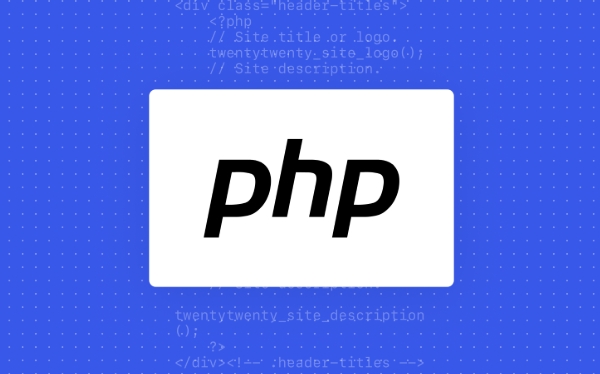PHP Explained: Server-Side Scripting Simplified
Jul 16, 2025 am 03:19 AMPHP is a server-side scripting language designed for web development. It runs on the server and after processing the code, it sends HTML and other content to the browser. Unlike client scripts (such as JavaScript), users cannot see the actual PHP code, only the output it generates. For example, PHP can connect to a database and display product lists dynamically. Reasons for PHP's popularity include: 1. Easy to learn; 2. Designed for web development; 3. Widely supported; 4. Having a large ecosystem; 5. Open source and flexible. PHP can be directly embedded in HTML files and run through local server environments (such as XAMPP). In short, PHP is a powerful tool for efficiently generating dynamic content.

PHP is a server-side scripting language designed for web development, but it can also be used as a general-purpose programming language. If you're new to PHP or looking to understand what makes it tick, the key idea is simple: PHP runs on the server, processes your code, and sends HTML (or other types of content) back to the browser.

What Exactly Is Server-Side Scripting?
Server-side scripting means that the code runs on the web server, not in the user's browser. When someone visits a webpage built with PHP, the server processes the PHP code first, executes any instructions (like fetching data from a database), and then sends the resulting HTML to the browser.
This is different from client-side scripting (like JavaScript), which runs after the page reaches the browser. With PHP, users never see the actual PHP code — only the output it generates.

For example:
- You have a PHP script that connects to a database and displays a list of products.
- The server runs this script when someone requests the page.
- It fetches product data, formats it into HTML, and sends that HTML to the visitor's browser.
Why Use PHP for Web Development?
There are several reasons why PHP has remained popular over the years:

- Easy to learn : PHP syntax is straightforward, especially if you already know a bit of C, Java, or JavaScript.
- Built for the web : PHP was created specifically for generating dynamic web pages, so it integrates smoothly with HTML.
- Widely supported : Most web hosting providers support PHP out of the box, making deployment easy.
- Large ecosystem : Popular tools like WordPress, Drupal, and Laravel are all powered by PHP.
- Open source : PHP is free to use and has a strong community contributing to its growth and documentation.
It's also flexible — you can write small scripts or build large applications using object-oriented programming and modern frameworks.
How Does PHP Fit Into a Web Page?
Let's say you're building a simple blog. Here's how PHP might come into play:
- A user visits
index.phpin their browser. - The server sees the
.phpextension and knows to run the PHP code inside the file. - That PHP code may connect to a MySQL database to retrieve recent blog posts.
- Once retrieved, PHP loops through the results and builds an HTML structure — maybe a list of post titles and excerpts.
- The final HTML is sent back to the browser, where the user sees the rendered blog homepage.
You can embed PHP directly into HTML files like this:
<!DOCTYPE html> <html> <body> <?php echo "Hello, world!"; ?> </body> </html>
When viewed in a browser, the user just sees “Hello, world!” — not the PHP code itself.
Setting Up a Basic PHP Environment
To start writing PHP, you need a few things:
- A text editor (like VS Code, Sublime Text, or even Notepad).
- A local server environment — options include XAMPP, WAMP, or MAMP.
- A browser to test your pages.
Once installed, place your .php files in the correct directory (like http://localhost/yourfile.php htdocs your browser.
If you're working on a live website, upload your PHP files to your web host via FTP or a control panel like cPanel.
That's the basic idea behind PHP and how it works on the server side. It's not magic — just a powerful tool that helps generate dynamic content efficiently.
The above is the detailed content of PHP Explained: Server-Side Scripting Simplified. For more information, please follow other related articles on the PHP Chinese website!

Hot AI Tools

Undress AI Tool
Undress images for free

Undresser.AI Undress
AI-powered app for creating realistic nude photos

AI Clothes Remover
Online AI tool for removing clothes from photos.

Clothoff.io
AI clothes remover

Video Face Swap
Swap faces in any video effortlessly with our completely free AI face swap tool!

Hot Article

Hot Tools

Notepad++7.3.1
Easy-to-use and free code editor

SublimeText3 Chinese version
Chinese version, very easy to use

Zend Studio 13.0.1
Powerful PHP integrated development environment

Dreamweaver CS6
Visual web development tools

SublimeText3 Mac version
God-level code editing software (SublimeText3)
 How to use PHP to build social sharing functions PHP sharing interface integration practice
Jul 25, 2025 pm 08:51 PM
How to use PHP to build social sharing functions PHP sharing interface integration practice
Jul 25, 2025 pm 08:51 PM
The core method of building social sharing functions in PHP is to dynamically generate sharing links that meet the requirements of each platform. 1. First get the current page or specified URL and article information; 2. Use urlencode to encode the parameters; 3. Splice and generate sharing links according to the protocols of each platform; 4. Display links on the front end for users to click and share; 5. Dynamically generate OG tags on the page to optimize sharing content display; 6. Be sure to escape user input to prevent XSS attacks. This method does not require complex authentication, has low maintenance costs, and is suitable for most content sharing needs.
 PHP calls AI intelligent voice assistant PHP voice interaction system construction
Jul 25, 2025 pm 08:45 PM
PHP calls AI intelligent voice assistant PHP voice interaction system construction
Jul 25, 2025 pm 08:45 PM
User voice input is captured and sent to the PHP backend through the MediaRecorder API of the front-end JavaScript; 2. PHP saves the audio as a temporary file and calls STTAPI (such as Google or Baidu voice recognition) to convert it into text; 3. PHP sends the text to an AI service (such as OpenAIGPT) to obtain intelligent reply; 4. PHP then calls TTSAPI (such as Baidu or Google voice synthesis) to convert the reply to a voice file; 5. PHP streams the voice file back to the front-end to play, completing interaction. The entire process is dominated by PHP to ensure seamless connection between all links.
 How to use PHP combined with AI to achieve text error correction PHP syntax detection and optimization
Jul 25, 2025 pm 08:57 PM
How to use PHP combined with AI to achieve text error correction PHP syntax detection and optimization
Jul 25, 2025 pm 08:57 PM
To realize text error correction and syntax optimization with AI, you need to follow the following steps: 1. Select a suitable AI model or API, such as Baidu, Tencent API or open source NLP library; 2. Call the API through PHP's curl or Guzzle and process the return results; 3. Display error correction information in the application and allow users to choose whether to adopt it; 4. Use php-l and PHP_CodeSniffer for syntax detection and code optimization; 5. Continuously collect feedback and update the model or rules to improve the effect. When choosing AIAPI, focus on evaluating accuracy, response speed, price and support for PHP. Code optimization should follow PSR specifications, use cache reasonably, avoid circular queries, review code regularly, and use X
 PHP creates a blog comment system to monetize PHP comment review and anti-brush strategy
Jul 25, 2025 pm 08:27 PM
PHP creates a blog comment system to monetize PHP comment review and anti-brush strategy
Jul 25, 2025 pm 08:27 PM
1. Maximizing the commercial value of the comment system requires combining native advertising precise delivery, user paid value-added services (such as uploading pictures, top-up comments), influence incentive mechanism based on comment quality, and compliance anonymous data insight monetization; 2. The audit strategy should adopt a combination of pre-audit dynamic keyword filtering and user reporting mechanisms, supplemented by comment quality rating to achieve content hierarchical exposure; 3. Anti-brushing requires the construction of multi-layer defense: reCAPTCHAv3 sensorless verification, Honeypot honeypot field recognition robot, IP and timestamp frequency limit prevents watering, and content pattern recognition marks suspicious comments, and continuously iterate to deal with attacks.
 PHP realizes commodity inventory management and monetization PHP inventory synchronization and alarm mechanism
Jul 25, 2025 pm 08:30 PM
PHP realizes commodity inventory management and monetization PHP inventory synchronization and alarm mechanism
Jul 25, 2025 pm 08:30 PM
PHP ensures inventory deduction atomicity through database transactions and FORUPDATE row locks to prevent high concurrent overselling; 2. Multi-platform inventory consistency depends on centralized management and event-driven synchronization, combining API/Webhook notifications and message queues to ensure reliable data transmission; 3. The alarm mechanism should set low inventory, zero/negative inventory, unsalable sales, replenishment cycles and abnormal fluctuations strategies in different scenarios, and select DingTalk, SMS or Email Responsible Persons according to the urgency, and the alarm information must be complete and clear to achieve business adaptation and rapid response.
 How to use PHP to combine AI to generate image. PHP automatically generates art works
Jul 25, 2025 pm 07:21 PM
How to use PHP to combine AI to generate image. PHP automatically generates art works
Jul 25, 2025 pm 07:21 PM
PHP does not directly perform AI image processing, but integrates through APIs, because it is good at web development rather than computing-intensive tasks. API integration can achieve professional division of labor, reduce costs, and improve efficiency; 2. Integrating key technologies include using Guzzle or cURL to send HTTP requests, JSON data encoding and decoding, API key security authentication, asynchronous queue processing time-consuming tasks, robust error handling and retry mechanism, image storage and display; 3. Common challenges include API cost out of control, uncontrollable generation results, poor user experience, security risks and difficult data management. The response strategies are setting user quotas and caches, providing propt guidance and multi-picture selection, asynchronous notifications and progress prompts, key environment variable storage and content audit, and cloud storage.
 Beyond the LAMP Stack: PHP's Role in Modern Enterprise Architecture
Jul 27, 2025 am 04:31 AM
Beyond the LAMP Stack: PHP's Role in Modern Enterprise Architecture
Jul 27, 2025 am 04:31 AM
PHPisstillrelevantinmodernenterpriseenvironments.1.ModernPHP(7.xand8.x)offersperformancegains,stricttyping,JITcompilation,andmodernsyntax,makingitsuitableforlarge-scaleapplications.2.PHPintegrateseffectivelyinhybridarchitectures,servingasanAPIgateway
 PHP integrated AI speech recognition and translator PHP meeting record automatic generation solution
Jul 25, 2025 pm 07:06 PM
PHP integrated AI speech recognition and translator PHP meeting record automatic generation solution
Jul 25, 2025 pm 07:06 PM
Select the appropriate AI voice recognition service and integrate PHPSDK; 2. Use PHP to call ffmpeg to convert recordings into API-required formats (such as wav); 3. Upload files to cloud storage and call API asynchronous recognition; 4. Analyze JSON results and organize text using NLP technology; 5. Generate Word or Markdown documents to complete the automation of meeting records. The entire process needs to ensure data encryption, access control and compliance to ensure privacy and security.






